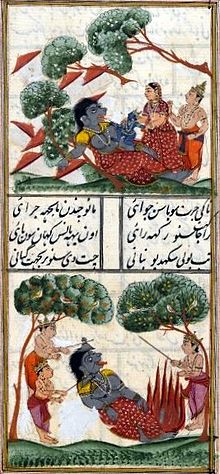ਪੂਤਨਾ

ਹਿੰਦੂ ਧਰਮ ਵਿਚ, ਪੂਤਨਾ (ਸੰਸਕ੍ਰਿਤ: ਪੁਤਨਾ, ਜਿਸਦਾ ਅਰਥ ਹੈ "ਸੜਨ") ਇੱਕ ਰਾਕਸ਼ਸੀ ਹੈ, ਜੋ ਸ਼ਿਸ਼ੂ-ਭਗਵਾਨ ਕ੍ਰਿਸ਼ਨ ਦੁਆਰਾ ਮਾਰੀ ਗਈ ਸੀ। ਪੁਤਨਾ ਨੂੰ ਕ੍ਰਿਸ਼ਨਾ ਦੀ ਧਰਮ ਮਾਂ ਵਜੋਂ ਵੀ ਮੰਨਿਆ ਜਾਂਦਾ ਹੈ ਕਿਉਂਕਿ ਉਹ ਉਸ ਨੂੰ ਦੁੱਧ ਚੁੰਘਾਉਂਦੀ ਸੀ, ਹਾਲਾਂਕਿ ਉਹ ਕ੍ਰਿਸ਼ਨ ਨੂੰ ਮਾਰਨ ਦੇ ਇਰਾਦੇ ਨਾਲ ਉਸ ਨੂੰ ਜ਼ਹਿਰ ਵਾਲਾ ਦੁੱਧ ਪਿਆਉਂਦੀ ਸੀ। ਉਸ ਦੇ ਬੁਰੇ ਇਰਾਦੇ ਨਾਲ, ਉਸ ਦੇ ਦੁੱਧ ਦੀ ਪੇਸ਼ਕਸ਼ ਕਰਕੇ, ਪੂਤਨਾ ਨੇ "ਮਾਂ ਦੀ ਸ਼ਰਧਾ ਦਾ ਸਭ ਤੋਂ ਵੱਡਾ ਕੰਮ" ਕੀਤਾ ਸੀ।[1] ਮਿਥਿਹਾਸ ਨੂੰ ਹਿੰਦੂ ਗ੍ਰੰਥਾਂ ਅਤੇ ਕੁਝ ਭਾਰਤੀ ਕਿਤਾਬਾਂ ਵਿੱਚ ਉਸ ਨੂੰ ਵੱਖ-ਵੱਖ ਤਰੀਕੇ ਨਾਲ ਇੱਕ ਦੁਸ਼ਟ ਆਚਰਨ ਜਾਂ ਇੱਕ ਦੁਰਵਿਹਾਰ ਵਜੋਂ ਦਰਸਾਇਆ ਗਿਆ ਹੈ ਜਿਸ ਨੇ ਆਪਣੇ ਆਪ ਨੂੰ ਕ੍ਰਿਸ਼ਨਾ ਨੂੰ ਸਮਰਪਿਤ ਕਰ ਦਿੱਤਾ ਸੀ, ਹਾਲਾਂਕਿ ਉਹ ਸ਼ੁਰੂ ਵਿੱਚ ਬੁਰੇ ਇਰਾਦਿਆਂ ਨਾਲ ਆਈ ਸੀ।
ਪੂਤਨਾ ਨੂੰ ਇੱਕ ਬਾਲ-ਰੋਗ ਜਾਂ ਪੰਛੀ ਦੇ ਤੌਰ 'ਤੇ ਦਰਸਾਇਆ ਗਿਆ ਹੈ, ਜੋ ਕ੍ਰਮਵਾਰ ਇੱਕ ਬਾਲ ਜਾਂ ਇੱਛਾ ਲਈ ਖਤਰੇ ਦਾ ਪ੍ਰਤੀਕ ਹੈ, ਅਤੇ ਇੱਕ ਪ੍ਰਤੀਕਾਤਮਕ ਬੁਰੀ ਮਾਂ ਵੀ ਹੈ। ਉਹ ਖਤਰਨਾਕ ਹਿੰਦੂ ਮਾਂ ਦੇਵੀਆਂ, ਜਿਨ੍ਹਾਂ ਨੂੰ ਮਾਤ੍ਰਿਕ ਕਿਹਾ ਜਾਂਦਾ ਹੈ, ਦੇ ਸਮੂਹ ਵਿੱਚ ਸ਼ਾਮਿਲ ਹੈ ਅਤੇ ਯੋਗਨੀਆਂ ਤੇ ਗ੍ਰਹਿਣੀਆਂ (ਸੀਜ਼ਰ) ਦੇ ਸਮੂਹ ਵਿੱਚ ਵੀ ਸ਼ਾਮਲ ਕੀਤਾ ਗਿਆ ਹੈ।ਪ੍ਰਾਚੀਨ ਭਾਰਤੀ ਮੈਡੀਕਲ ਟੈਕਸਟ ਬੱਚਿਆਂ ਨੂੰ ਬਿਮਾਰੀਆਂ ਤੋਂ ਬਚਾਉਣ ਲਈ ਉਸਦੀ ਪੂਜਾ ਦਾ ਨੁਸਖ਼ਾ ਦਿੰਦੇ ਹਨ। ਪ੍ਰਾਚੀਨ ਭਾਰਤੀ ਗ੍ਰੰਥਾਂ ਵਿਚਕਈ ਪ੍ਰਕਾਰ ਦੀ ਪੂਤਨਾ ਦੇ ਸਮੂਹ ਦਾ ਜ਼ਿਕਰ ਕੀਤਾ ਗਿਆ ਹੈ।
ਨਿਰੁਕਤੀ[ਸੋਧੋ]
ਸ਼ਬਦ "ਪੂਤਨਾ", ਜੋ "ਪੂਤ" (ਗੁਣ) ਅਤੇ "ਨਾ" (ਨਾਂਹ) ਦੇ ਤੌਰ 'ਤੇ ਤੋੜੇ ਗਏ ਹਨ, ਦਾ ਭਾਵ "ਗੁਣ ਤੋਂ ਰਹਿਤ" ਹੈ। ਇੱਕ ਹੋਰ ਵਿਆਖਿਆ "ਪੁਤ" ਤੋਂ "ਪੁਤਨਾ" (ਸ਼ੁੱਧ ਹੋਣ) ਦੀ ਹੈ, ਜਿਸਦਾ ਅਰਥ ਹੈ "ਉਹ ਜੋ ਸ਼ੁੱਧ ਕਰਦੀ ਹੈ।" ਹਬਰਬਰਟ ਨੇ "ਪੂਤਨਾ" ਨੂੰ "ਪੂਤ, ਹਿੰਦੂ ਮਿਥਿਹਾਸ ਵਿੱਚ ਇੱਕ ਨਰਕ ਹੈ, ਤੋਂ ਬਣਿਆ ਦੱਸਿਆ ਹੈ ਜੋ ਮਾਪਿਆਂ ਅਤੇ ਬੱਚਿਆਂ ਨਾਲ ਸੰਬੰਧਿਤ ਹੈ।[2] ਇਸ ਪ੍ਰਕਾਰ, ਹਰਬਰਟ ਨਿਰੁਕਤੀ ਦੇ ਆਧਾਰ 'ਤੇ ਮਾਤ੍ਰਿਕਸ ਨਾਲ ਉਸ ਦੇ ਸੰਬੰਧਾਂ ਦਾ ਸੁਝਾਅ ਦਿੱਤਾ ਹੈ, ਜੋ ਪੂਤਨਾ ਮਾਤਾ ਦੇ ਨਾਲ ਜੁੜੇ ਹੋਏ ਹਨ।[3] ਪੂਤਨਾ ਨੂੰ ਚੇਚਕ ਦੀ ਦੇਵੀ ਦਾ ਰੂਪ ਜਾਂ ਹਥਿਆਰ ਵੀ ਕਿਹਾ ਜਾਂਦਾ ਹੈ।[4]

ਇੱਕ ਪੰਛੀ ਦੇ ਰੂਪ ਵਿੱਚ ਚਿੱਤਰਨ[ਸੋਧੋ]
ਪੁਤਨਾ ਨੂੰ ਬੁੱਤ ਅਤੇ ਮਿੱਥ ਵਿੱਚ ਇੱਕ ਪੰਛੀ ਦੇ ਰੂਪ ਵਿੱਚ ਦਰਸਾਇਆ ਗਿਆ ਹੈ। ਇੱਕ ਪੰਛੀ ਦੇ ਰੂਪ ਵਿੱਚ ਪੂਤਨਾ ਦੇ ਕੁਸ਼ਾਣ ਚਿੱਤਰ ਮਥੁਰਾ, ਦਿਓਗੜ ਅਤੇ ਮੰਡੋਰ ਵਿੱਚ ਮਿਲਦੇ ਹਨ।[4] ਹਰੀਵੰਸ ਦੀ ਤੀਜੀ ਸਦੀ ਦੇ ਇੱਕ ਵਰਨਨ ਵਿੱਚ, ਪੂਤਨਾ ਨੂੰ " ਕੰਸ ਦੀ ਨਰਸ" ਕਿਹਾ ਗਿਆ ਹੈ, ਜੋ ਕਿ ਇੱਕ ਮਾਦਾ ਪੰਛੀ (ਸ਼ਾਕੁਨੀ) ਦੇ ਰੂਪ ਵਿੱਚ ਇੱਕ ਬੱਚੇ ਨੂੰ ਲਿਆਉਂਦੀ ਹੈ, ਅਤੇ ਹਰੀਵੰਸ ਵਿੱਚ ਜ਼ਿਕਰ ਕੀਤੇ ਬਹੁਤ ਸਾਰੀਆਂ ਮਾਦਾ ਪੰਛੀਦੇਵੀਆਂ ਵਿੱਚੋਂ ਇੱਕ ਹੈ।[5] ਪੁਤਨਾ ਦਾ ਪੰਛੀ ਰੂਪ ਭੌਤਿਕਵਾਦੀ ਉਦੇਸ਼ਾਂ ਦੀ ਇੱਛਾ ਵੱਲ ਸੰਕੇਤ ਕਰਦਾ ਹੈ।[6] ਕੁਝ ਪਾਠਾਂ ਵਿੱਚ, ਪੂਤਨਾ ਦਾ ਵਾਕੀ, ਦੇ ਤੌਰ 'ਤੇ ਵਿਖਿਆਨ ਕੀਤਾ ਗਿਆ ਹੈ, ਇਸ ਪ੍ਰਕਾਰ ਇਹ ਬੁੱਧੀ ਅਤੇ ਪਖੰਡ ਦਾ ਪ੍ਰਤੀਕ ਹੈ।[7]
ਨੋਟਸ[ਸੋਧੋ]
ਹਵਾਲੇ[ਸੋਧੋ]
- Agrawal, V.S. (1996). "Putana and Yasoda". In Shashi, Shyam Singh. Encyclopaedia Indica. Anmol Publications PVT. LTD. ISBN 81-7041-859-3.<span class="cx-segment" data-segmentid="169">.mw-parser-output cite.citation{font-style:inherit}.mw-parser-output .citation q{quotes:"\"""\"""'""'"}.mw-parser-output .citation .cs1-lock-free a{background:url("//upload.wikimedia.org/wikipedia/commons/thumb/6/65/Lock-green.svg/9px-Lock-green.svg.png")no-repeat;background-position:right .1em center}.mw-parser-output .citation .cs1-lock-limited a,.mw-parser-output .citation .cs1-lock-registration a{background:url("//upload.wikimedia.org/wikipedia/commons/thumb/d/d6/Lock-gray-alt-2.svg/9px-Lock-gray-alt-2.svg.png")no-repeat;background-position:right .1em center}.mw-parser-output .citation .cs1-lock-subscription a{background:url("//upload.wikimedia.org/wikipedia/commons/thumb/a/aa/Lock-red-alt-2.svg/9px-Lock-red-alt-2.svg.png")no-repeat;background-position:right .1em center}.mw-parser-output .cs1-subscription,.mw-parser-output .cs1-registration{color:#555}.mw-parser-output .cs1-subscription span,.mw-parser-output .cs1-registration span{border-bottom:1px dotted;cursor:help}.mw-parser-output .cs1-ws-icon a{background:url("//upload.wikimedia.org/wikipedia/commons/thumb/4/4c/Wikisource-logo.svg/12px-Wikisource-logo.svg.png")no-repeat;background-position:right .1em center}.mw-parser-output code.cs1-code{color:inherit;background:inherit;border:inherit;padding:inherit}.mw-parser-output .cs1-hidden-error{display:none;font-size:100%}.mw-parser-output .cs1-visible-error{font-size:100%}.mw-parser-output .cs1-maint{display:none;color:#33aa33;margin-left:0.3em}.mw-parser-output .cs1-subscription,.mw-parser-output .cs1-registration,.mw-parser-output .cs1-format{font-size:95%}.mw-parser-output .cs1-kern-left,.mw-parser-output .cs1-kern-wl-left{padding-left:0.2em}.mw-parser-output .cs1-kern-right,.mw-parser-output .cs1-kern-wl-right{padding-right:0.2em}</span>
- Dimmitt, Cornelia; Buitene, Johannes Adrianus Bernardus (1978). "Putana: The Child Killer". Classical Hindu Mythology: A Reader in the Sanskrit Purāṇas. Temple University Press. ISBN 0-87722-122-7.
- Gopal, T. V. (2000). Hrishikesa. Universal-Publishers. ISBN 1-58112-732-4.
- Herbert, J. (1996). "Sakata and Putana". In Shashi, Shyam Singh. Encyclopaedia Indica. Anmol Publications PVT. LTD. ISBN 81-7041-859-3.
- Kakar, Sudhir (2002). "Cults and myths of Krishna". In Devy, G. N. (ed.). Indian Literary Criticism: Theory and Interpretation. Orient Blackswan. ISBN 81-250-2022-5.
- Kakar, Sudhir (1978). The Inner World: A Psychoanalytic Study of Childhood and Society in India. Delhi.
- O'Flaherty, Wendy Doniger (1982). Women, Androgynes, and Other Mythical Beasts. University of Chicago Press. ISBN 0-226-61850-1.
- Olson, Carl (2007). ""Putana's arrival in Vraj" from Bhagavata Purana". Hindu Primary Sources: A Sectarian Reader. Rutgers University Press. ISBN 0-8135-4070-4.
- White, David Gordon (2003). Kiss of the yoginī: "Tantric Sex" in its South Asian contexts. University of Chicago Press. pp. 51–53. ISBN 978-0-226-89483-6.
